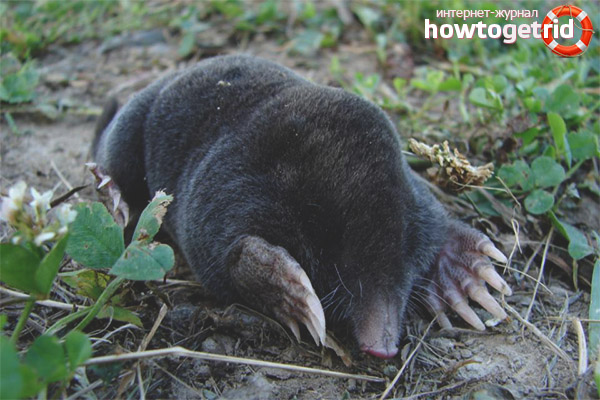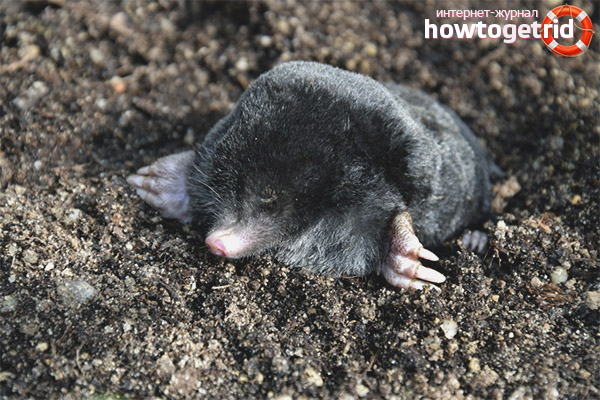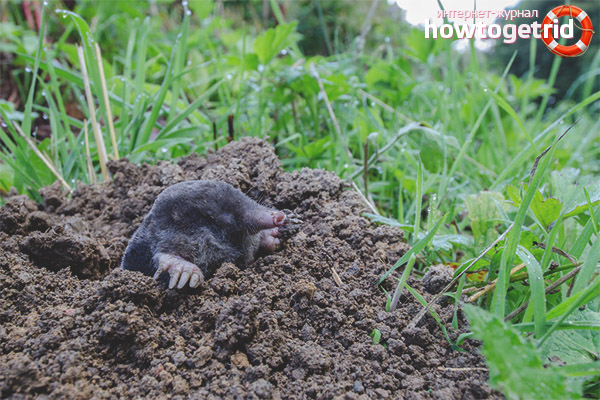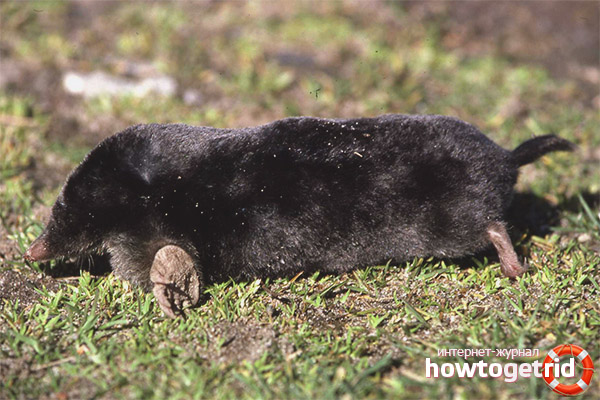The content of the article
Animal mole - a subclass of the beast, belongs to the mammalian class. Also included in the order of insectivores and shrews. Scientists consider the European mole one of the funniest and most interesting animals. In educational literature, he is also found under the name ordinary.
Description
Since, for most of life, almost 99%, the European mole is underground, it has large and strong forepaws, remotely resembling shovels. The body length of an adult animal is approximately 13-17 centimeters, the tail can reach 5 centimeters and the weight varies from 65 to 123 grams. All moles have small eyes with a narrow click of no more than 0.5 mm. Another feature of the animal is that it does not have an external ear.
At a young age, the color of the animal is much lighter than that of an adult animal. There are several types of colors in nature:
- White, with scorched flowers.
- A variety of brown and gray.
The European mole is able to move back and forth along its burrows - this is due to the fact that the tail of the mole has tactile hairs. Since the movement of this animal is quite active, the fur cover is very often wiped. The nose is quite peculiar, the nostrils are on the sides.
What does it eat?
The menu of the European mole is varied. It includes:
- invertebrate family (most often earthworms);
- slugs;
- wood lice;
- different types of insects (caterpillars, beetles, bears);
- spiders
- centipedes;
- mice
- frogs.
The most important thing is that the “food” is not moving fast. The food allowance at one time can reach no more than 25 g of worms, in 24 hours - no more than 60-70 g of various foods. Unlike other mammals, an ordinary mole can live without food for a maximum of 18 hours, after which it dies. For the winter period, the mole is stocked up all summer, most often these are paralyzed earthworms. Although hibernation is not characteristic of this animal, it takes significantly less food during this period than in summer.
What are the differences between male and female?
In nature, the female and the male, in addition to the usual sexual accessories, have no differences. Both in appearance and in behavior in the environment are no different.
How does it behave in the environment?
Most of the animal’s life process is digging the earth. Thus, he moves in the direction he needs. The process itself looks like a mole is drilling a tunnel, and the ground is scattering the front paws.
Lives exclusively in soft soil, since the animal’s teeth are not strong enough to gnaw hard breeds. Broken tunnels of the animal are also often used by other, smaller animals, often being food for the mole.
In addition to land habitat, the mole is able to swim, however, it should be a small river or a lake. It appears extremely rarely on the surface of the earth, because it is too clumsy, and moves almost crawl, leaving behind a corresponding groove with paw prints.
Throughout life, it breaks through a mass of labyrinths up to 6 cm in diameter.In appearance, such labyrinths resemble multi-tiered children's playgrounds. The depth of the structures is up to about 60 cm. The animal divides its labyrinths-moves into two types:
Residential - which the beast uses as a kind of transition from a watering hole to aft passages.
Fodder is the so-called trap where small mammals are caught - animals that serve as a diet for the mole. On average, these traps reach up to 5cm in depth. Outside, they are very easy to notice, the “cap” of such a trick is slightly raised;
The place serving as a nest is the most protected, and is located underground at a depth of two meters. The animal tries to hide it under stones, stumps, roots in very inaccessible places for anyone. Between aft and residential passages are connected only by inclined special passages.
It is interesting! In one night, the animal is able to dig a tunnel up to 40 meters.
The habitat is visually very easy to detect, the mole throws excess land to the surface. The beast is active all 12 months, does not hibernate, like many other inhabitants of the forest. Tunnels digging below frozen soil. In the case of severe frosts, the earth may freeze by a meter or more. Under such conditions, most often the mole perishes from a lack of food. With hot summers, droughts, almost the same process occurs.
Already an adult animal is very attached to its hole and even if it is carried far away, it will still return “home”. A young animal can leave its native nest for its settlement by about 2-3 kilometers. The European mole does not like neighbors, it is aggressive. Sometimes it can even kill. Such an animal lives for about 5-6 years.
How does it breed?

Reproduction in the European mole, as in many animals, begins in the spring, from about mid-March to early May. The duration of pregnancy in a female is up to 42 days. An ordinary mole is born bald and blind, weighing no more than three grams. For one litter, the female can lead from two to ten small moles. For 12 months, the female brings one litter, in very rare cases two. After one month, the animal reaches the size of an almost adult animal.
In the process of growing up, the animal becomes non-caring and aggressive towards its brethren. In about one and a half to two months, the animal leaves its parental nesting, and independently digs its own, in which there will be no "neighbors and roommates."
Natural opponents
European moles as they feed on animals less than themselves, and are food for large predators. But due to the specific smell they remain alive, many predators refuse to hunt for an ordinary mole. The most common opponents in natural selection are:
- foxes;
- martens;
- affection;
- owl;
- buzzard.
Throughout life, the European mole is sick with pyroplasmosis (transmitted from tick bites) and tularemia. It is a “dining room” for fleas, ticks, worms and other parasites.
Advantages and disadvantages
Cons of the appearance of the mole:
- The moles bring huge damage to gardeners. Since the gardens have very soft soil and a large number of insects and other animals, which are food for the mole, are concentrated, they are based in such places. They destroy the root system of plants with their blasts, after which it begins to dry and dies in a short period of time.
- If the mole constantly lives on the site, sooner or later the land loses all its fertile properties, and every year the harvest becomes smaller and poorer.
- The European mole feeds on the earthworm, and it, in turn, brings great benefits to the fields and gardens.
The benefits of a mole
Despite the large amount of damage that the animal brings, there are also positive aspects. The animal feeds on harmful larvae, field mice.
Curious facts
- The European mole has a very large population, therefore it is not protected as a species by law.Previously valued for its velvet-like fur. The skin is very strong, but pleasant to the touch, previously mined in large quantities. To date, people have virtually abandoned production from such material.
- Mole common is very useful in natural selection, thanks to its diet, the soil is deprived of harmful insects, larvae, worms and at the same time enriched with organic substances.
- Constant loosening favorably affects the condition of the soil. The flow of moisture and oxygen to the underground areas improves.
In developed countries, the fight against animals occurs in a humane way. For example, many people use pungent preparations (people resort to chopped onions, garlic or kerosene). They also use loud sounds, ultrasounds. Today, a large number of devices with ultrasonic scare are released.
Video: European mole (Talpa europaea)












Submit